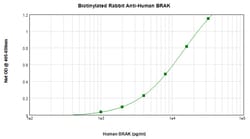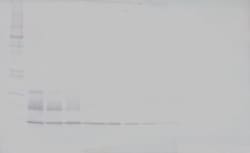Learn More
CXCL14 Polyclonal Antibody, Biotin, PeproTech®, Invitrogen™
Rabbit Polyclonal Antibody
$2175.00
Specifications
| Antigen | CXCL14 |
|---|---|
| Concentration | 0.1-1.0 mg/mL |
| Applications | ELISA, Western Blot |
| Classification | Polyclonal |
| Conjugate | Biotin |
| Catalog Number | Mfr. No. | Quantity | Price | Quantity & Availability | |||||
|---|---|---|---|---|---|---|---|---|---|
| Catalog Number | Mfr. No. | Quantity | Price | Quantity & Availability | |||||
50-271-8584

|
Invitrogen™
500P237BT500UG |
500 μg |
Each of 1 for $2,175.00
|
|
|||||
Description
AA Sequence of recombinant protein: SKCKCSRKGP KIRYSDVKKL EMKPKYPHCE EKMVIITTKS VSRYRGQEHC LHPKLQSTKR FIKWYNAWNE KRRVYEE. Preparation: Produced from sera of rabbits immunized with highly pure Recombinant Human BRAK (CXCL14). Anti-Human BRAK (CXCL14)-specific antibody was purified by affinity chromatography and then biotinylated. Sandwich ELISA: To detect hBRAK by sandwich ELISA (using 100 μL/well antibody solution) a concentration of 0.25-1.0 μg/mL of this antibody is required. This biotinylated polyclonal antibody, in conjunction with PeproTech Polyclonal Anti-Human BRAK (500-P237) as a capture antibody, allows the detection of at least 0.2-0.4 ng/well of Recombinant hBRAK. Western Blot: To detect hBRAK by Western Blot analysis this antibody can be used at a concentration of 0.1-0.2 μg/mL. Used in conjunction with compatible secondary reagents the detection limit for Recombinant hBRAK is 1.5-3.0 ng/lane, under either reducing or non-reducing conditions. 500-P237BT-1MG will be provided as 2 x 500 μg
This gene belongs to the cytokine gene family which encode secreted proteins involved in immunoregulatory and inflammatory processes. The protein encoded by this gene is structurally related to the CXC (Cys-X-Cys) subfamily of cytokines. Members of this subfamily are characterized by two cysteines separated by a single amino acid. This cytokine displays chemotactic activity for monocytes but not for lymphocytes, dendritic cells, neutrophils or macrophages. It has been implicated that this cytokine is involved in the homeostasis of monocyte-derived macrophages rather than in inflammation.Specifications
| CXCL14 | |
| ELISA, Western Blot | |
| Biotin | |
| Rabbit | |
| Human | |
| O95715 | |
| 9547 | |
| E.coli-derived Recombinant Human BRAK (CXCL14). | |
| Antigen affinity chromatography | |
| Cxcl14 |
| 0.1-1.0 mg/mL | |
| Polyclonal | |
| Lyophilized | |
| RUO | |
| PBS with no preservative | |
| 1110031L23Rik; 1200006I23Rik; AI414372; B-cell and monocyte-activating chemokine; BMAC; bolekine; BRAK; breast and kidney; C Cmotif chemokine; C X C motif chemokine; CC motif chemokine; CCmotif chemokine; chemokine (C-X-C motif) ligand 14; chemokine BRAK; CXC; CXC chemokine in breast and kidney; CXC motif chemokine; C-X-C motif chemokine 14; C-X-C motif chemokine ligand 14; CXCL; Cxcl14; hypothetical protein LOC511771; Kec; Kidney-expressed chemokine CXC; KS1; MGC10687; MIP-2 gamma; MIP2G; MIP-2g; MIP2gamma; musculus CXC chemokine MIP-2gamma; NJAC; PSEC0212; SCYB14; small inducible cytokine B14; small inducible cytokine subfamily B (Cys-X-Cys), member 14; small inducible cytokine subfamily B (Cys-X-Cys), member 14 (BRAK); small-inducible cytokine B14; tumor-suppressing chemokine; UNQ240/PRO273 | |
| Cxcl14 | |
| Primary | |
| -20°C |
The Fisher Scientific Encompass Program offers items which are not part of our distribution portfolio. These products typically do not have pictures or detailed descriptions. However, we are committed to improving your shopping experience. Please use the form below to provide feedback related to the content on this product.


